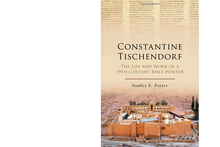The Bible hunter
The name ‘Constantine Tischendorf’ is unfamiliar to most British evangelicals, and one suspects that a biography about a man whose most famous achievement was the discovery of a fourth-century manuscript would not seem the most exciting story, at least compared to a biography about a Christian MP who freed the slaves (William Wilberforce), or an evangelist who led multitudes to Christ (George Whitefield) or a pioneer missionary (such as William Carey).
Dr Anthony McRoy, scholar in the field of Islamic Studies

CONSTANTINE TISCHENDORF:
The Life and Work of a 19th Century
Bible Hunter
By Stanley E. Porter
Bloomsbury. 200 pages. £16.99
ISBN 978 0 567 658 029
Neither was Tischendorf a kind of evangelical ‘Indiana Jones’, battling evil men and ancient trap-doors to recover some priceless ancient artefact. However, his story is important, not least because what he did and later wrote is even more relevant today than at its original publication, as we face attacks upon the integrity of the Bible from atheist and especially Islamic propagandists, the latter at ground level in schools, colleges and on the streets.
Admirably lucid
Porter is Professor of New Testament at McMaster Divinity College, Canada, and is obviously also an able and popular writer. The book is admirably lucid, accessible and engrossing. The author is doubtless aware of how such a topic, dealing with admittedly technical issues, can be a great turn-off for the average reader and he has managed to present the story in such a way as to grip the layman.
Apart from the bibliography in Part III, the book is divided into two main sections, the first part looking at Tischendorf’s life, then his work, and the second part being a re-publication of Tischendorf’s seminal work When Were Our Gospels Written? Such is the strength of this work in terms of continued usefulness that Porter has only added two footnotes – the first being to the translator’s point that at that time (1866), liberal scholarship held that the Fourth Gospel was only written around the middle of the second century (p.116), a position Porter notes has since been abandoned, and the second to Tischendorf’s assertion that The Acts of Pilate is genuine (p.153), which Porter observes is very much a minority view.
Exemplary scholar
The early part of Tischendorf’s life is briefly presented. He was born in 1815 in the Kingdom of Saxony (at a time when Germany was still divided) and it is no surprise that we learn he was an exemplary scholar at the prestigious Leipzig University – not only in terms of theology, but also (perhaps surprisingly for one so dedicated to unearthing ancient manuscripts) poetry – he even published poems and a novel (p.13).
He thus seems to have been a reasonably well-rounded individual. His interest in textual criticism was spawned by the theological controversies then raging in Germany – the liberalism that attacked ‘the veracity of the New Testament’ (p.17).
Combatting liberalism
We have already seen how liberals claimed that the Fourth Gospel was of very late emergence, and so could be neither authentically written by John, nor be an accurate history of Jesus. Tischendorf realised that in order to combat such claims, it was necessary to establish a critical edition of the NT, based on the earliest manuscripts. It is this which makes his work so vital today – Islamic missionaries are always attacking the text of the Bible as well as its interpretation, and so to defend the latter it is essential to have a firm defence of the former. The closer the manuscripts are in age to the first century, the more reliable the text, and less the possibility of corruption.
Interestingly, despite several calls for such in recent years, Muslims have never produced a critical edition of the Qur’an.
Overcoming the Vatican
Tischendorf’s cause was not easy, because access to the earliest known manuscript, Codex Vaticanus, was restricted by the Vatican. Yet his determination was unbounded and, influenced by the archaeological finds associated with Napoleon’s short occupation of Egypt, Tischendorf set out for the Near East. He eventually reached the ancient St Catherine’s Monastery in Sinai in 1844, the first of three visits (p.25). Porter makes an important point at this juncture that Tischendorf’s conduct was entirely honourable – some writers have claimed that he misbehaved in his attempts to secure manuscripts from the monastery.
Uninterested monks
Tischendorf was troubled by the lack of interest the monks showed in their library: ‘I perceived in the middle of the great hall a large and wide basket, full of old parchments, and the librarian... told me that two heaps of papers like these, mouldered by time, had been already committed to the flames. What was my surprise to find amid this heap of papers a considerable number of sheets of a copy of the Old Testament in Greek, which seemed to me to be one of the most ancient I had ever seen.’
He had discovered the fourth century Codex Sinaiticus. One cannot but help wince at the thought that precious manuscripts had been burnt as useless waste-paper! He was allowed to take 43 sheets, which ended up in Leipzig University.
Hunting manuscripts
In the years that followed Tischendorf really did hunt out Bible manuscripts (and other ancient texts that had bearing on his purposes) in other parts of Europe and the Near East and, especially considering that this was in a time without aviation or advanced transport, one can only admire his dedication with gratitude.
Eventually making two other trips to St Catherine’s, on the third journey he managed to gain the patronage of the Czar, traditional protector of Orthodox Christians, and Codex Sinaiticus was presented to the Czar. In 1933, the atheist Communist regime, having no use for Bible texts, sold it to Britain, where it is now lodged in the British Library. The codex helped to undermine aspects of liberalism.
Defending Scripture
Unlike any fictional archaeologist, Tischendorf’s work was not motivated by the glamour of excitement, glory or the advancement of knowledge for its own sake, but rather to defend the veracity of Scripture.
He knew that history was indeed ‘His Story’, and that God’s revelation, effected in history, would be objectively trustworthy. Hence his desire to find as many old manuscripts as possible, to fend off contemporary attacks on the reliability of Scripture. His very accessible work When Were Our Gospels Written? examines manuscript evidence as well as citations from the early church fathers, gospel harmonies, the testimony of Papias, etc.
Dealing with Islam today
This is an essential approach when dealing with modern Islamic polemics, and although further advances in manuscripts have been made since Tischendorf, his work remains a lucid and valuable introduction to the defence of Biblical trustworthiness for ordinary Christians.
Indeed, Porter’s work, containing both the biography and When Were Our Gospels Written? would be an excellent book to buy in bulk for a youth group, especially for those about to go to university where they will face large and active Islamic societies who will assault the reliability of the Bible, and whose charges are ably met by Tischendorf.

